In the realm of avian majesty, two iconic predators command our attention: the fish eagle and the Bald Eagle. These noble creatures, distinguished by their captivating appearances and remarkable behaviors, hold significance both in the natural world and in human culture.
From their distinct physical attributes to their hunting techniques and ecological roles, the fish eagle and the Bald Eagle each present a unique story of adaptation and survival.
This exploration delves into the multifaceted differences that shape these eagles, shedding light on their symbolic importance, ecological significance, and the fascinating intricacies that define their existence.

Key Differences Between Fish Eagle and Bald Eagle
Fish eagles and bald eagles are both impressive raptors, but they belong to different genera and are found in different parts of the world.
Here are some key differences between them:
Head Color
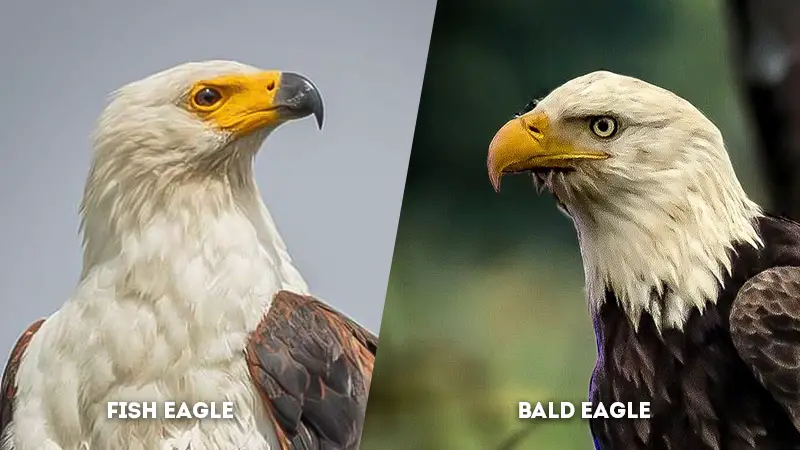
- Fish Eagle: The fish eagle, such as the African Fish Eagle, displays a remarkable white head and neck, extending down to its upper chest. This distinctive white plumage stands out against the eagle’s brown body and contributes to its recognizable appearance.
The white head and neck are well-suited for aquatic habitats, camouflaging the eagle as it surveys water bodies for potential prey. - Bald Eagle: In contrast, the iconic Bald Eagle boasts a white head that is instantly recognizable. Its dark brown body is complemented by this striking white crown, a key feature that has made it a symbol of strength and freedom in various cultures.
The white head, along with its yellow beak and piercing yellow eyes, sets the Bald Eagle apart from other eagles and contributes to its majestic aura.
Neck Color
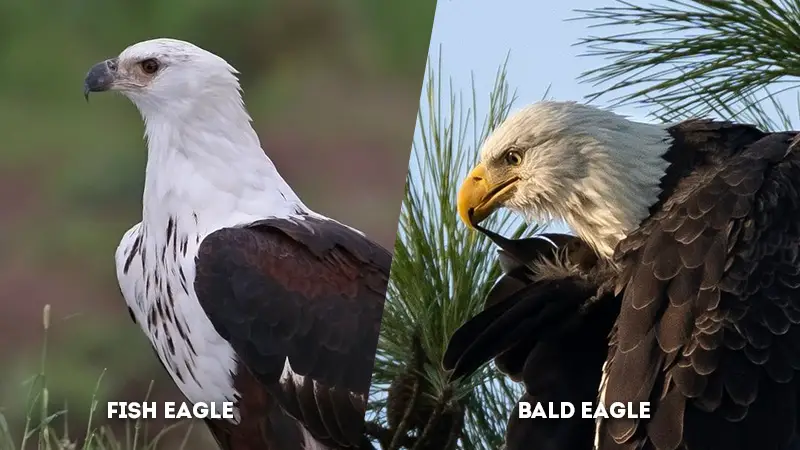
- Fish Eagle: The fish eagle, exemplified by species like the African Fish Eagle, showcases a distinct white neck that seamlessly extends from its white head.
This creates a visually striking contrast with the bird’s predominantly brown body. The white neck, often considered an adaptation to its aquatic habitat, aids in camouflage while the eagle scans the water’s edge for potential prey. - Bald Eagle: Conversely, the Bald Eagle’s neck is not white like its head; instead, it is covered in the same dark brown feathers that make up the majority of its body. This creates a smooth transition from the white head to the brown body, highlighting the sharp contrast and distinctive coloration that sets the Bald Eagle apart.
Tail Color
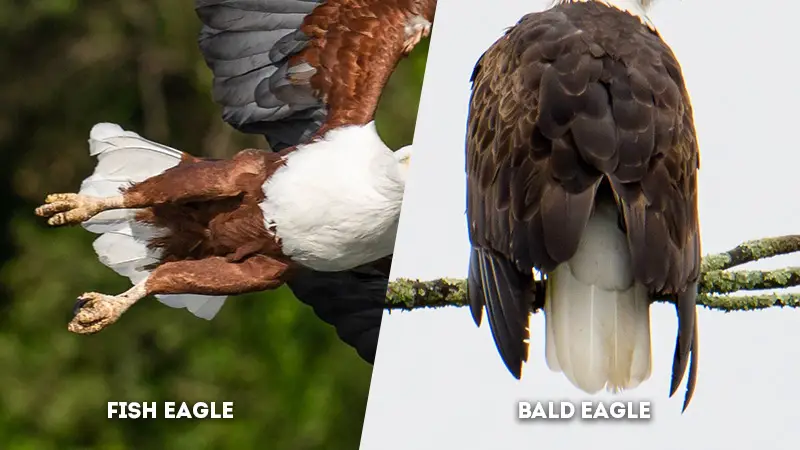
- Fish Eagle: The tail color of the fish eagle mirrors its neck, often displaying a striking white hue. This continuation of white from the head and neck down to the tail feathers serves not only an aesthetic purpose but also assists the bird in its hunting endeavors.
The whitetail can be seen from a distance and may help the eagle navigate its surroundings, especially in dim light or dense foliage near water bodies. - Bald Eagle: The Bald Eagle’s tail is a defining feature, being predominantly white in color. This whitetail stands in stark contrast against the bird’s dark brown body, making it easily identifiable even from a distance.
As the eagle soars through the sky or perches on trees overlooking its hunting grounds, the white tail feathers catch the eye and contribute to its commanding presence.
Eye Color
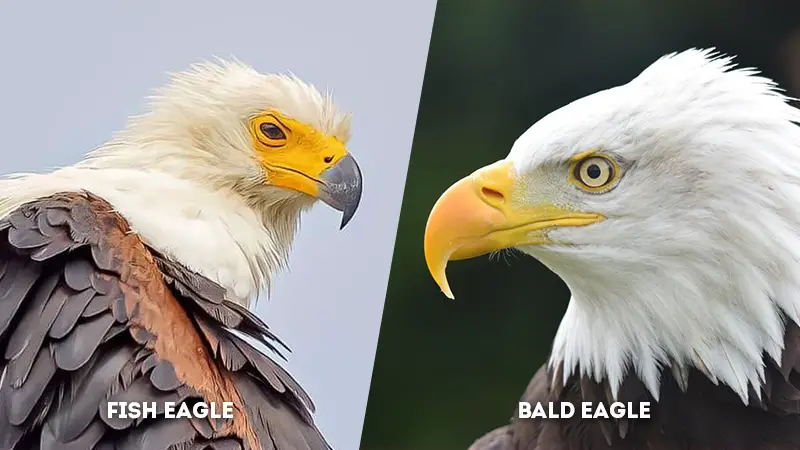
- Fish Eagle: The eyes of the fish eagle are usually dark in color. This darker eye color provides a subtle yet important contrast to the bird’s white head and neck, enhancing its overall appearance.
The eyes of the fish eagle are adapted to its hunting habits near water bodies, helping it spot fish or other prey beneath the water’s surface. - Bald Eagle: One of the most distinctive features of the Bald Eagle is its bright yellow eyes. These vibrant eyes, set against the white head, create an arresting and intense gaze.
The yellow eye color is not only visually captivating but also serves a functional purpose, aiding the eagle in spotting movement and potential prey from great distances.
Beak Color
- Fish Eagle: The color of the beak in fish eagles can vary among different species. Some may have yellow beaks, while others might have black or other dark-colored beaks. This variation can be influenced by the species’ habitat, diet, and genetics.
- Bald Eagle: The Bald Eagle’s beak is another distinctive feature that complements its overall appearance.
The beak is yellow, matching the color of its eyes and standing out against its dark brown body. This bright beak adds to the eagle’s striking visual impact and, like its eyes, aids in prey detection and hunting activities.
Body Color
- Fish Eagle: The body color of fish eagles can vary among different species, but it generally includes shades of brown with white accents.
For example, the African Fish Eagle sports a brown body with a distinctive white head, neck, and tail. This coloration serves as a practical adaptation for hunting over aquatic environments. - Bald Eagle: The Bald Eagle is characterized by its dark brown body, which provides a stark contrast to its white head and tail feathers.
This coloration reflects its role as a predatory bird of prey. The dark feathers aid in camouflage while hunting, allowing it to blend into the forested landscapes and bodies of water where it hunts for food.
Feather Pattern
- Fish Eagle: The feather pattern of fish eagles typically includes a combination of mottled and solid-colored feathers. The contrast between the white head, neck, and tail and the brown body feathers contributes to its distinct appearance.
This pattern not only aids in camouflage but also showcases the bird’s adaptation to its aquatic lifestyle, where the white portions might help it blend with the reflections on the water’s surface. - Bald Eagle: The Bald Eagle boasts a striking feather pattern that features a clear demarcation between its white head and tail and its dark brown body.
This bold contrast helps observers easily distinguish the Bald Eagle from other species. The feather pattern showcases the bird’s majestic presence and serves as a visual symbol of strength and freedom.
Wing Span
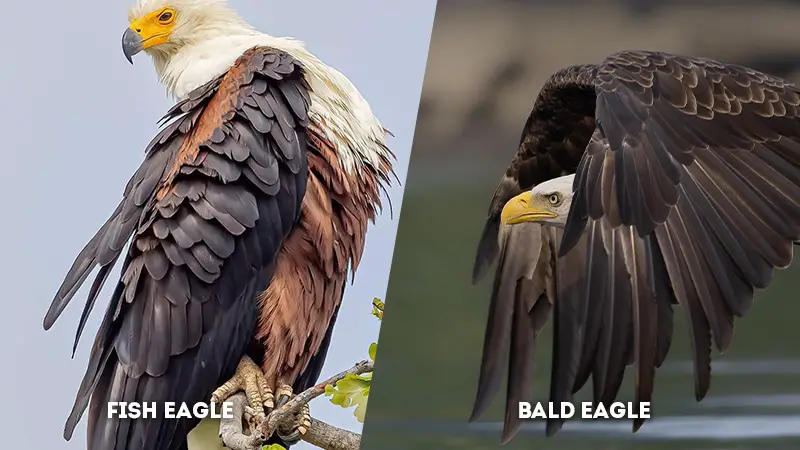
- Fish Eagle: Fish eagles, depending on the species, can exhibit varying wing spans. These can range from moderate to quite extensive.
This adaptation allows them to soar gracefully above bodies of water as they search for fish and other aquatic prey. The broad wings provide ample surface area for effective gliding and hovering over water surfaces. - Bald Eagle: The Bald Eagle is renowned for its impressive wingspan, which can exceed 6 feet (1.8 meters) in some individuals.
This extensive wingspan allows the eagle to take advantage of thermal updrafts, enabling it to glide effortlessly through the skies while conserving energy.
The wingspan also supports the bird’s exceptional hunting techniques, such as its signature aerial dives to catch fish.
Habitat
- Fish Eagle: Fish eagles are often associated with aquatic habitats, including rivers, lakes, and coastal areas. These environments provide an abundant source of fish, the primary diet of fish eagles.
Their preference for these habitats showcases their specialization for hunting and surviving in watery landscapes. - Bald Eagle: The Bald Eagle’s habitat is diverse and includes various types of ecosystems, primarily centered around bodies of water.
While they are strongly associated with lakes, rivers, and coastal areas, Bald Eagles are also found in forested regions and near wetlands.
This adaptability to different habitats reflects their ability to exploit a wide range of food sources, from fish to birds and small mammals.
Geographical Range
- Fish Eagle: Fish eagles have a global distribution, with different species found on nearly every continent. For instance, the African Fish Eagle is prevalent across sub-Saharan Africa, while the Osprey, often called a “fish hawk,” is found on every continent except Antarctica. This wide distribution reflects the adaptability of these eagles to various aquatic ecosystems.
- Bald Eagle: The Bald Eagle’s range is more limited, mainly concentrated in North America. The species is especially prominent in the United States and Canada, where it holds the status of a national emblem.
Its range extends from Alaska to the Gulf of Mexico and from the Atlantic to the Pacific coasts. While they are found primarily in North America, Bald Eagles can occasionally be spotted in other areas due to their migratory behavior and occasional vagrancy.
Species Diversity
- Fish Eagle: Fish eagles encompass a variety of species with distinct characteristics. These include the African Fish Eagle, Osprey, and various sea eagles found around the world.
Each species showcases unique adaptations and behaviors tailored to their specific environments. - Bald Eagle: In contrast, the Bald Eagle is a singular species, scientifically known as Haliaeetus leucocephalus. As the national bird and symbol of the United States, the Bald Eagle’s prominent status has led to its widespread recognition and association with American patriotism.
Primary Diet
- Fish Eagle: True to their name, fish eagles predominantly feed on fish. Their sharp talons and keen eyesight enable them to spot fish from great heights before swooping down to catch their prey. This specialization in piscivorous hunting has shaped their physical characteristics and behaviors.
- Bald Eagle: While fish also constitute a significant portion of the Bald Eagle’s diet, these eagles exhibit a broader diet spectrum.
They are opportunistic hunters that can catch fish, birds, and small mammals. Scavenging for carrion is also a common behavior for Bald Eagles, showcasing their adaptability to different food sources.
Nesting Habits
- Fish Eagle: Fish eagles, particularly sea eagles like the Bald Eagle, are known for their affinity to water bodies.
They often build nests near the water’s edge, utilizing trees or rocky outcrops as nesting sites. This proximity to water facilitates their fishing and hunting activities. - Bald Eagle: The Bald Eagle’s nesting habits similarly demonstrate a connection to aquatic environments. They prefer tall trees, often located along coastlines, rivers, and lakes.
Their nests are massive structures called eyries, constructed from sticks and lined with softer materials. These nests can reach impressive sizes and are used and improved upon over many breeding seasons.
Nest Structure
- Fish Eagle: Fish eagle nests are relatively simple compared to those of the Bald Eagle. They tend to be less structured, with fewer sticks and materials forming the base.
This might be due to the aquatic environments in which fish eagles often reside, where natural materials for nest-building might be scarcer. - Bald Eagle: Bald Eagles are renowned for their elaborate nest structures. Over the years, they continue to add sticks and materials to their nests, resulting in massive, layered eyries that can weigh several tons. These nests provide stable platforms for raising their young and have been known to persist for decades.
Vocalization
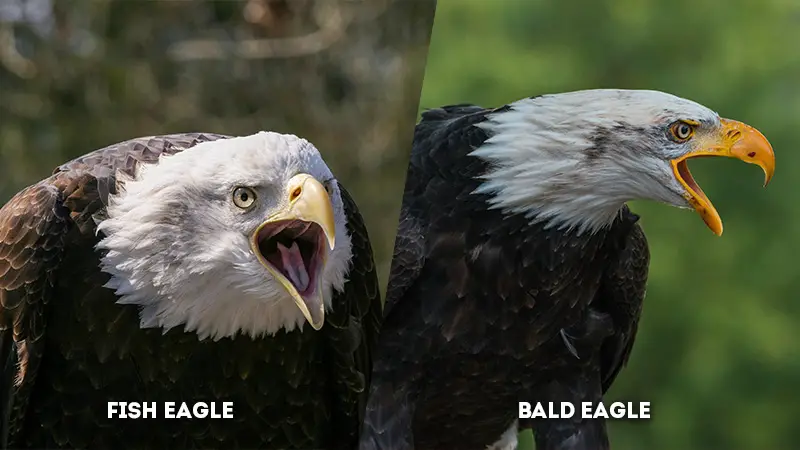
- Fish Eagle: Fish eagles are recognized for their distinctive calls, which often resonate near water bodies. These calls can range from melodious whistles to sharp, piercing cries that may serve to communicate with their mates, establish territory, or signal their presence to other birds.
- Bald Eagle: Bald Eagles possess a diverse repertoire of vocalizations, each with its own purpose. They emit a variety of calls, including high-pitched whistles, chatters, and even shrill screams. Their vocalizations are integral to social interactions, mating behaviors, and territorial disputes.
Migration Behavior
- Fish Eagle: Migration behavior varies among fish eagle species. Some are sedentary, residing year-round in their habitat, while others are migratory, undertaking seasonal movements to find suitable breeding or feeding grounds.
For example, the Osprey is a migratory fish eagle, traveling long distances between its breeding and wintering areas. - Bald Eagle: The Bald Eagle demonstrates a migratory behavior primarily among its northern populations. These eagles migrate to more temperate regions during the colder months, seeking open water and more abundant food sources. Southern populations, however, often remain in their territories year-round.
Wing Shape
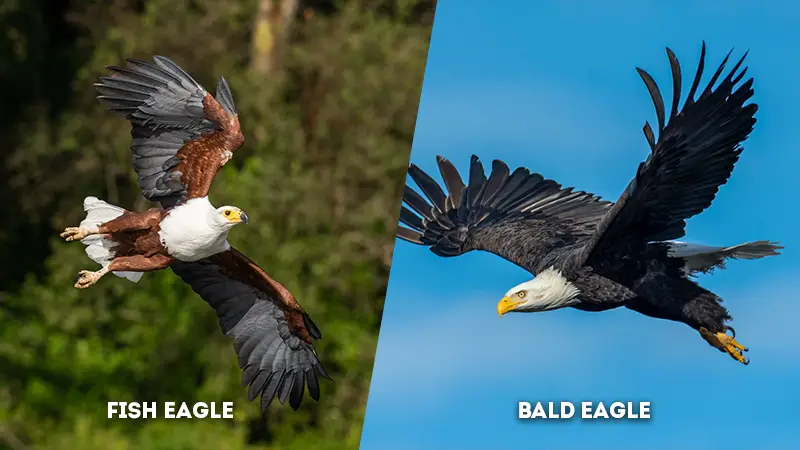
- Fish Eagle: Fish eagles typically possess broad wings that are well-suited for soaring and gliding. This wing shape allows them to effectively patrol water bodies from the air and make precise dives to catch fish. The wing structure supports their hunting behavior and the need for agile movement above water.
- Bald Eagle: The Bald Eagle shares a similar wing shape with fish eagles, featuring broad and robust wings.
This wing design enables them to glide effortlessly while searching for prey from elevated perches. Their wings are also integral to their fishing techniques, facilitating their iconic stoop (rapid dive) into the water to seize fish.
Feeding Strategy
- Fish Eagle: The primary feeding strategy of fish eagles revolves around their remarkable hunting skills in aquatic environments.
Their sharp eyesight helps them locate fish near the water’s surface, and their adept flying and diving techniques allow them to plunge into the water to capture their prey. This specialization in fishing has shaped their behavior, physiology, and habitat preferences. - Bald Eagle: While fishing is a notable aspect of the Bald Eagle’s feeding strategy, it is more versatile in its food choices. In addition to fish, Bald Eagles also hunt birds, small mammals, and carrion.
They are opportunistic predators, scavenging for food when the opportunity arises and displaying a broader range of hunting techniques compared to fish eagles.
Ecosystem Role
- Fish Eagle: Fish eagles play a vital role as apex predators in aquatic ecosystems. By controlling fish populations, they help maintain the balance of food chains and contribute to the overall health of water bodies.
Additionally, their nest-building activities can affect tree populations and other species that rely on the same habitat. - Bald Eagle: The Bald Eagle serves as an important apex predator in its ecosystems, exerting control over various prey species.
Its presence can have cascading effects on the populations of smaller animals, which in turn can influence vegetation and other elements of the ecosystem. Their nests provide shelter to other species as well.
Conservation Status
- Fish Eagle: The conservation status of fish eagles varies based on the species and their specific habitats. Some species, like the African Fish Eagle, are not currently considered threatened. However, other species, such as the Madagascar Fish Eagle, are critically endangered due to habitat loss and other human-induced factors.
- Bald Eagle: The Bald Eagle has made a remarkable recovery in the United States. Once facing significant population declines due to factors like habitat destruction and DDT poisoning, the Bald Eagle’s conservation status has improved significantly. It was removed from the U.S. Endangered Species list in 2007, reflecting successful conservation efforts.
Symbolic Importance
- Fish Eagle: Fish eagles hold cultural significance in various regions due to their presence near water bodies, often associated with life and sustenance.
While they might not hold the same level of global symbolism as the Bald Eagle, their importance within local cultures reflects the deep connections between humans and their environment. - Bald Eagle: The Bald Eagle’s symbolic importance is unparalleled. It is a national emblem and symbolizes freedom, strength, and independence, particularly in the United States.
This eagle’s representation on flags, currency, and official seals highlights its role as an icon of national identity and values.
Physical Size
- Fish Eagle: The physical size of fish eagle species can vary widely, with some smaller species like the Osprey having wingspans around 5 feet (1.5 meters) and others like the Steller’s Sea Eagle boasting wingspans of up to 9 feet (2.7 meters). Their size often corresponds to their specific habitats and the types of prey they target.
- Bald Eagle: The Bald Eagle is notably large, with an average wingspan of 6 to 7 feet (1.8 to 2.1 meters). Females are typically larger than males, showcasing sexual dimorphism. This substantial size enhances its predatory capabilities and contributes to its majestic presence.
Distinctive Features
- Fish Eagle: Fish eagles, like the African Fish Eagle, are recognized for their white heads, which serve as a sharp contrast to their brown bodies. Their distinctive plumage aids in identification and adaptation to aquatic environments where they hunt for fish.
- Bald Eagle: The Bald Eagle’s white head and tail are iconic features that set it apart. Paired with its yellow beak and piercing yellow eyes, these distinct traits make the Bald Eagle instantly recognizable. These features contribute to its image as a symbol of power and freedom.
Hunting Techniques
- Fish Eagle: Fish eagles employ specialized hunting techniques for aquatic environments. They use their sharp eyesight to locate fish near the water’s surface.
Upon spotting prey, they execute precise dives into the water to catch fish with their talons. This strategy demands agility and accuracy. - Bald Eagle: The Bald Eagle employs a versatile approach to hunting. While fish are a significant part of their diet, they also capture birds, small mammals, and carrion.
Their hunting techniques include soaring and gliding to spot prey from a distance, as well as aerial dives to seize it. This adaptability aids in survival.
Eyesight
- Fish Eagle: Fish eagles possess remarkable eyesight, adapted for spotting fish from considerable heights. Their keen vision allows them to accurately assess the movements of fish near the water’s surface, enabling them to execute swift and successful hunting dives.
- Bald Eagle: The Bald Eagle’s eyesight is equally impressive. With vision four to eight times sharper than that of humans, it can spot prey from great distances. This exceptional eyesight is integral to its hunting strategies and survival in its various habitats.
Behavioral Adaptations
- Fish Eagle: Fish eagles exhibit behavioral adaptations that align with their aquatic lifestyle. They are skilled at diving from heights into water to catch fish, often performing these dives with precision. Their nesting near water bodies facilitates easy access to their primary food source.
- Bald Eagle: The Bald Eagle’s behavioral adaptations encompass a wider range of strategies. Apart from hunting, they engage in scavenging and stealing food from other birds.
They are also known for their territorial behavior and impressive courtship displays, involving aerial acrobatics and vocalizations.
Scientific Name
- Fish Eagle: The term “fish eagle” encompasses various species from different genera. For instance, the African Fish Eagle is classified as Haliaeetus vocifer, while the Osprey is known as Pandion haliaetus. These scientific names reflect their evolutionary lineages and characteristics.
- Bald Eagle: The scientific name of the Bald Eagle is Haliaeetus leucocephalus. The genus “Haliaeetus” refers to sea eagles, while “leucocephalus” translates to “white head” in Greek, perfectly describing this eagle’s defining feature.
Fish Eagle Vs Bald Eagle: Comparison Table
| Feature | Fish Eagle | Bald Eagle |
|---|---|---|
| Head Color | White head and neck, extending to upper chest | White head |
| Neck Color | White | Dark brown neck |
| Tail Color | White | White tail |
| Eye Color | Dark | Yellow |
| Beak Color | Varies, often yellow or black | Yellow |
| Body Color | Varies, usually brown with white accents | Dark brown |
| Feather Pattern | Distinctive white head and neck | White head and tail |
| Wing Span | Varies by species, generally wide | Impressive wingspan |
| Habitat | Found near water bodies, rivers, and lakes | Various habitats, often near water |
| Geographical Range | Global distribution, varies by species | Mainly North America |
| Species Diversity | Several species with unique characteristics | Single species: Haliaeetus leucocephalus |
| Primary Diet | Fish | Fish, birds, and small mammals |
| Nesting Habits | Builds large nests in trees near water | Nests in tall trees near water |
| Nest Structure | Often large and elaborate | Large stick nests |
| Vocalization | Distinctive calls, often heard near water | Variety of calls, including high-pitched whistles |
| Migration Behavior | Some species migratory, others sedentary | Northern populations are migratory |
| Wing Shape | Broad wings for soaring and hunting | Strong, broad wings for flying |
| Feeding Strategy | Hunts by diving from heights into water | Scavenges and hunts live prey |
| Ecosystem Role | Top predator in aquatic environments | Apex predator with significant ecological impact |
| Conservation Status | Varies by species, some are threatened | Least Concern (Haliaeetus leucocephalus) |
| Symbolic Importance | National emblem of several countries | National bird and symbol of the United States |
| Physical Size | Size varies by species | Impressive size, with females larger than males |
| Distinctive Features | White head and neck, sharp beak | Yellow beak, bright yellow eyes |
| Hunting Techniques | Aerial dives for catching fish | Skilled hunter, uses both aerial and perch hunting |
| Eyesight | Excellent vision for spotting prey | Acute vision for locating prey |
| Behavioral Adaptations | Adapted for aquatic hunting and fishing | Versatile behaviors, including scavenging |
| Scientific Name | Various species, e.g., Haliaeetus leucogaster | Haliaeetus leucocephalus |
Frequently Asked Questions
Fish eagles communicate through a range of vocalizations, including distinctive calls and cries. These vocalizations serve purposes like territorial assertion, mate attraction, and signaling the presence of predators or prey. Their calls often resonate around water bodies where they primarily hunt and reside.
The Bald Eagle’s massive nests, called eyries, have a notable impact on their ecosystems. When the eagles abandon old nests, they provide shelter and nesting sites for other bird species, such as owls and vultures. This nesting behavior creates a positive ripple effect by benefiting multiple species in the ecosystem.
Yes, in various cultures, fish eagles hold symbolic significance. For instance, some African cultures view the African Fish Eagle as a symbol of power and spirituality. In Native American traditions, the Bald Eagle is revered for its connection to the spiritual world and is considered a messenger between humans and the divine.
The Bald Eagle population faced a decline due to habitat destruction and pollutants like DDT. However, dedicated conservation efforts, including the ban of DDT and the protection of nesting sites, played a pivotal role in the eagle’s recovery. This success story highlights the potential positive impact of human interventions on endangered species.
Both fish eagles and Bald Eagles possess superior eyesight compared to humans. Their eyes are adapted to detect movements and details over long distances. They have a higher concentration of color-sensitive cells called cones, which aid in identifying prey. Additionally, they have a second fovea, a small pit in the retina, enhancing their ability to focus on specific points in their field of vision.
To Recap
The fish eagle and the Bald Eagle stand as awe-inspiring testaments to the diversity of life on our planet. Their distinct characteristics and roles in various ecosystems demonstrate the intricate dance between nature’s design and adaptation.
As symbols of cultural significance and ecological importance, these eagles remind us of the delicate balance required for a harmonious coexistence between humans and the natural world.
Through their soaring flights, piercing cries, and majestic presence, these eagles embody the wonder and splendor of the animal kingdom, inspiring admiration and a deeper connection to the world around us.